Asia’s key trends, potentials, opportunities and outlook
Asian Development Bank Annual Meeting, Manila, PhilippinesNaoyuki Shinohara
IMF Deputy Managing Director
May 2, 2012
As prepared for delivery
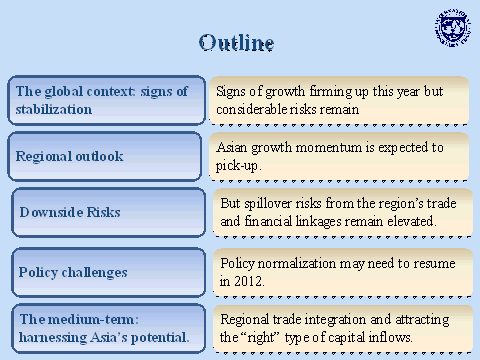
1. I will focus my talk today on the global economy and the Asian economy: I will talk about the current growth recovery the world is experiencing, the factors that are holding back the recovery, and the risks facing this recovery in the short term. I will then move on to our central forecast for the Asian region, and some of the looming risks there. Finally, I will touch on some medium-term opportunities for the region: harnessing these opportunities will be crucial for the region to maximize its potential.
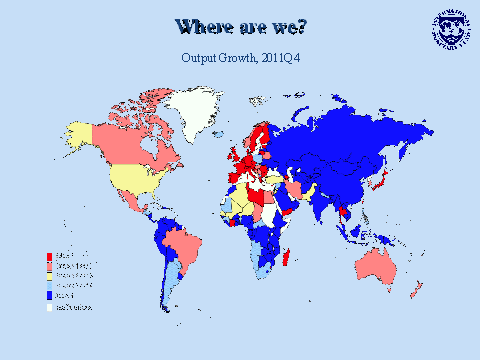
2. Let me start by looking at a snapshot of growth performance in the world. This slide highlights where we were in terms of growth at the end of last year. It clearly shows the weakness of advanced economies, particularly in Europe, at the end of last year. The ranges for output growth across the world are captured by the colors, and you can see that growth was weakest in Europe, and it was strongest in Asia and parts of Latin America and Africa. For Europe the primary cause is the weakness of both the sovereigns and banks in the euro area. What I am talking about here are the high public debt levels; the resulting high and rising Euro Area bond rates; and the high unemployment rates that are an ongoing consequence of the Great Recession.
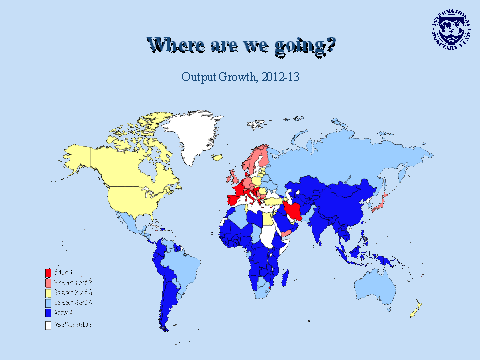
3. So that was where we were in end 2011, and this map now shows were we will be going in the next two years. The main message here is that the outlook is poor but improving. We expect the World economy to grow at 3.5 percent this year and 4.1 percent in 2013, but the growth will be very uneven. Europe is still expected to have very weak growth overall. Countries in the periphery will go through outright recessions and advanced European countries like France and Germany will have only modest growth of 1 percent. But other economies, such as the US and a number of countries in Asia and in Africa are forecast to gradually strengthen from their end 2011 performance. Why isn’t the global economy recovering faster than that? I will talk now about three main brakes that are preventing a stronger recovery.

4. The first brake on the global economy is fiscal consolidation. Advanced countries all plan to consolidate their fiscal positions this year, by about 1 percent of GDP on average. The adjustment planned in the European periphery, in particular, is quite substantial. Overall, average consolidation in Eurozone countries will be about 1.6 percent of GDP. This will be an important break on global growth. To give you a rough quantification of this impact, if we assume a multiplier of about 1, which is not unrealistic, this planned consolidation will by itself shave off 1 percent of the global growth rate this year.
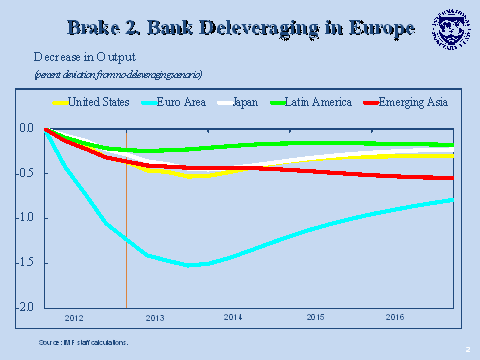
5. The second brake on the global economy is bank deleveraging. We expect bank balance sheets to shrink in the next 2-3 years, most strongly in Europe (and this is incorporated in the IMF's baseline projections just published in April). This would imply a strong retrenchment in credit to the private sector by a number of major banks, which would be quite damaging to growth. This chart shows some simulations for the impact of the European bank deleveraging. The impact is presented here as loss in output compared to a no-deleveraging scenario. As you can see, output losses from deleveraging are expected to be particularly large in Europe, with output losses exceeding 1 percent this year, and peaking at more than 1.5 percent in 2013.
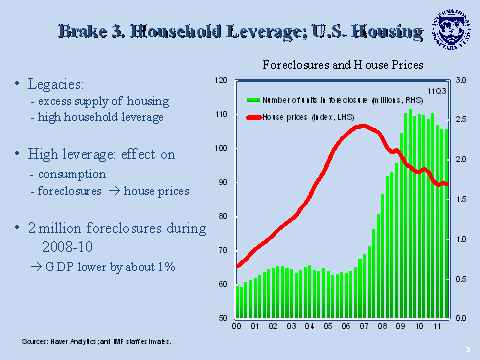
6. The 3rd and last brake I will talk about is mainly a US story. As you know very well, the global crisis was mostly the result of excessive household leveraging and the proliferation of excessively risky mortgages extended by US banks. Five years after the outbreak of the crisis, we are still struggling with the legacy of excess supply of housing and high household leverage. The number of units under foreclosures remains very high, causing downward pressure on house prices. This situation is imposing a significant drag on consumption, a main engine of growth in the US. To give you an idea, back-of the envelope calculations we have made suggest that the foreclosures during 2008-10 cost about 1 percent of US GDP in total.

7. So far I have talked about the global outlook. Before moving on to Asia, let me just touch on one of the major risks to the global economy that we see in the months ahead. This is the risk stemming from vicious cycles and negative feedback loops in Europe.
8. The blue lines in the slide above summarize these negative connections, that run from weak/negative growth to weak banks and/or fiscal problems. These feedback loops are at the heart of the crisis in Europe today. But we must recognize also the policy actions that the European authorities have taken or are taking to address these risks. The yellow arrows try to capture these policy efforts and how they help break the vicious cycles. For example, the ECB's LTROs (Long-Term Refinancing Operations) have eased funding strains for banks, and both the ECB’s SMP program (Sovereign Market Purchases) and the EU's firewall have eased the funding strains for governments. And the fiscal compact helps because it increases fiscal credibility and therefore alleviates fiscal risks, which breaks the adverse contagion channel from large fiscal funding needs to growth or to the banking sector. Having said that, the policies introduced so far only alleviate the adverse loops but do not eliminate them. More is needed to completely break these loops.
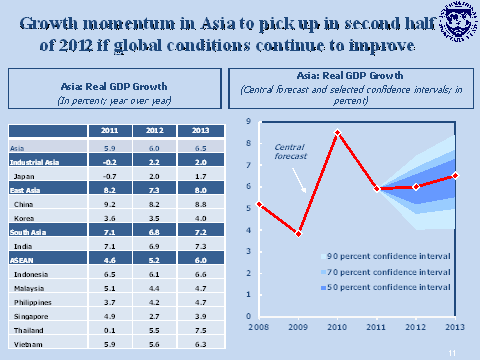
9. Turning to the region now: The forecast for the Asia and Pacific region is essentially unchanged from the January 2012 World Economic Outlook Update: growth in 2012 will continue at the same pace as in 2011, and then rebound in 2013. This forecast, however, reflects a combination of considerably lower growth in Emerging Asia—particularly in the first half of 2012 and in the more open and trade-dependent economies—and a sharp rebound in Industrial Asia. Industrial Asia is projected to grow at about 2 percent in 2012, as Japan and New Zealand recover strongly from the natural disasters and favorable demand conditions for commodities provide a boost to Australia. But growth in Emerging Asia as a whole is expected to decline from 7½ percent in 2011 to below 7 percent in 2012, before recovering in 2013.
10. Growth in the region is expected to gain momentum by the second half of 2012 and into 2013. External demand is projected to improve in line with better growth performance in the euro area from the third quarter of this year, although, of course, this forecast is subject to much uncertainty. At the same time, the fundamentals for domestic demand, including strong labor markets, are expected to remain solid across the region.
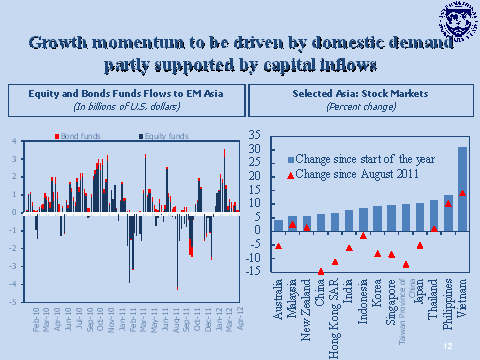
11. A resumption of strong capital flows to Emerging Asia over 2012 and 2013 is expected to sustain private consumption and investment across the region, by boosting confidence and contributing to a loosening of financial conditions. In the first quarter of 2012, equity inflows have rebounded from the retrenchment in 2011:Q4, many local currencies have appreciated against the US dollar, and stock markets have posted strong gains.
12. The resumption of strong capital inflows is not without risk, however. As long as the outlook in emerging markets remains more favorable than the outlook in advanced economies, capital is likely to continue to flow from advanced to emerging markets, exerting overheating pressures as well as appreciation pressures in the latter. From a more medium term perspective, as growth in Asia becomes increasingly driven by domestic demand, this will coincide with an exchange rate adjustment. Expectations for this happening may be an additional factor driving capital inflows to emerging markets. Appreciation pressures may therefore become excessive, and the risk of overshooting may call for policy action to try to slow down excessive appreciation. The situation could become even more complicated if uncertainty in the global economy increases, leading to excess volatility in capital flows and creating boom and bust cycles.
13. I have just talked about an important risk facing emerging markets today—the risks from too strong or too volatile capital inflows—or a combination of both.
Let me now turn to other downside risks facing the economy.
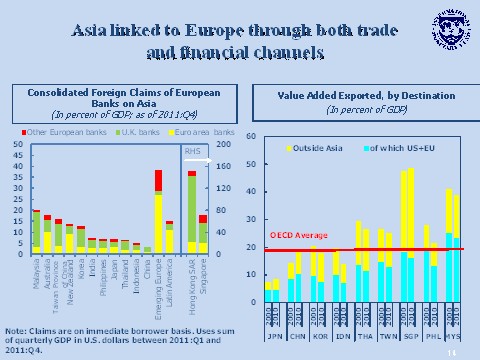
14. Downside risks in Asia remain high. The most immediate concern is, as mentioned earlier, a resurgence of the euro area crisis: Asia’s trade and financial linkages with Europe imply that spillovers to the region could be considerable.
15. These charts try to capture some of the financial linkages between Europe and Asia (left chart) as well as some of the trade linkages (right chart). If global interbank markets were to become paralyzed again—as during the Lehman crisis—and European banks were to deleverage in a disorderly and aggressive manner, this could significantly impact credit supply in Asia. Although Asian economies on average rely less than comparator regions on euro area and U.K. banks, these banks nonetheless are very active in Asia—both in the area of direct credit, including trade finance, and in the area of wholesale funding of regional banks, particularly in Australia, Hong Kong SAR, Korea, New Zealand, Singapore, and Taiwan Province of China. But it is also important to bear in mind that in some Asian economies European banks’ local claims tend to be funded mainly through local deposits, reducing the risk of a disorderly deleveraging.
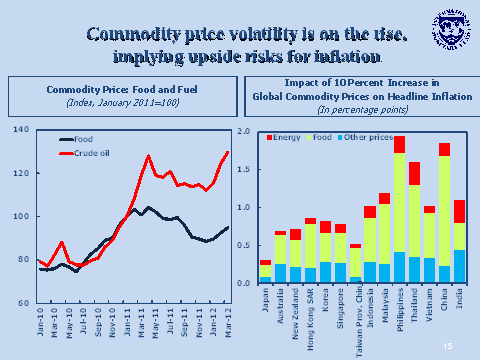
16. Another risk comes from commodity and food prices. Geopolitical tensions could push oil prices sharply higher given low global inventories and spare capacity. The impact on economies in the region would vary, reflecting among other things their dependence on oil and, if the shock also affects other commodity and food prices, reflecting also their approach to stabilizing these prices domestically. For most Asian economies the pass through from global commodity prices to inflation is substantial and reaches nearly 20 percent in the case of China and the Philippines. The impact would also depend on how well inflation expectations are anchored. Although headline CPI inflation has declined since mid 2011 across the region, the main cause was base effects and many economies have seen a rise of inflationary expectations since the beginning of 2012.
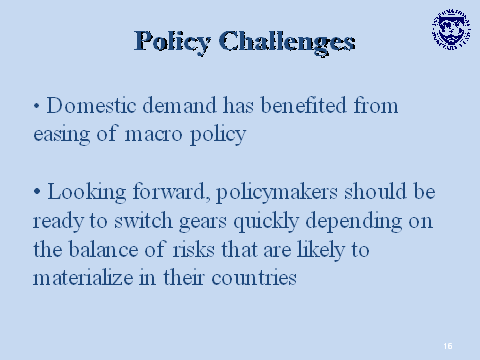
17. Asia’s economic performance has been supported over the past couple of years by relatively expansionary monetary and fiscal policies. In fact, domestic demand benefited from continued easing of macro policy stances across most of the region.
18. Delaying the return to more neutral macroeconomic policy stances after the aggressive post-crisis easing has been prudent, given the severe downside risks to Asia from the fragile global economy. But with acute financial tensions receding, and capital inflows rebounding, and inflation expectations picking up, policymakers in the region should stand ready to resume the tightening cycle at a faster pace than expected earlier this year. Of course, the balance of risks and the need for switching gears quickly differs from country to country.
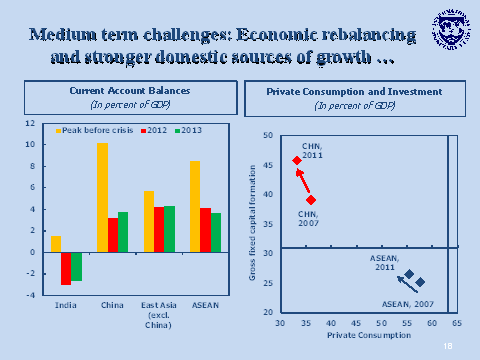
19. Over the medium term, Asian countries need to strengthen domestic sources of growth in the region. The recent and projected decline of current account surpluses in emerging Asia, including in China and the ASEAN economies, has raised hopes that progress is being made. However, to some extent the recent decline is cyclical and reflects weaker external demand. It is thus uncertain, if this progress is sustainable over time. Moreover, in China, excessively low consumption has weakened further since the beginning of the Global Financial Crisis. Instead, domestic demand has been driven by strong investment, raising concerns about excess capacity and bank balance sheets. For ASEAN economies, the reduction of current account surpluses has also coincided with an increase in investment ratios but these appear more sustainable in light of the investment gap that separates them from other emerging markets.
20. Finally, let me touch on two other challenges to sustain growth in the medium term: Regional trade integration, and attracting greater inward FDI.
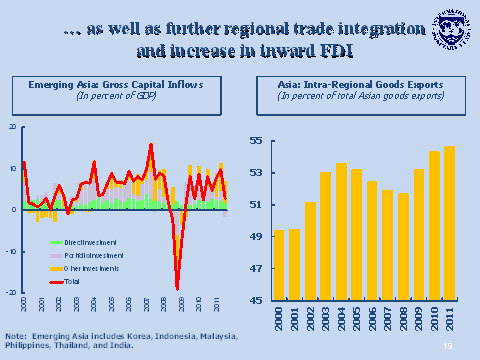
21. One of the most striking trends in Asia’s rise as the world’s leading source of exports has been the growth in intraregional trade. While global trade and Asia’s trade with economies outside the region have doubled since 2000, intra-Asian trade has tripled. Asian economies increasingly have formed a supply network, with China taking the role of an assembly hub for final goods exports, notably consumer goods.
22. The most immediate benefit of this increased trade integration in the region is the buffer it creates vis-à-vis a shock from Europe or the US. But, given the importance of vertical supply chain links with China, exports of other Asian countries to China would suffer if China’s exports continue to slow. By contrast, increasing direct and indirect access to the Chinese consumer good markets could offer lasting benefits for Asian trading partners.
23. As for foreign direct investment (FDI): this is not only a relatively stable source of finance; it also offers the most direct growth benefits. Asia’s record of attracting FDI has been patchy (left chart). In the run-up to the crisis, FDI as a share of GDP expanded less quickly than portfolio and bank inflows, and it remains relatively low. This represents an untapped opportunity. Greater FDI inflows could help some of the persistent investment shortages in parts of the region such as the ASEAN countries. FDI could transfer valuable technological expertise and bring countries closer to the international technology frontier, while potentially serving as a source of finance in critical areas such as infrastructure development.

No comments:
Post a Comment